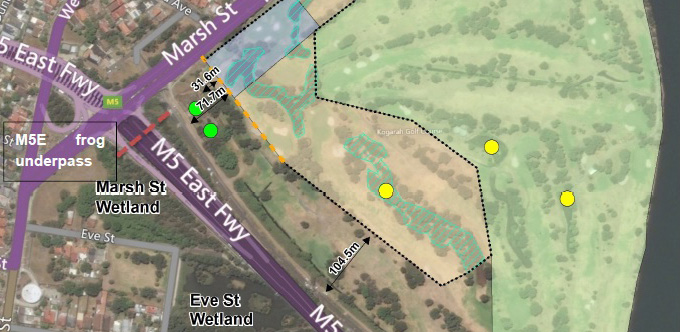
Source for this section: Eco Logical Australia 2016. Green and Golden Bell Frog Plan of Management - Arncliffe. Prepared for NSW Roads and Maritime Service (the RMS plan).
When the original M5 was built through Arncliffe between Eve Street and the site of the current golf course, the RTA (Roads and Traffic Authority, the department preceding the RMS), in order to preserve the GGBF population, built two ponds for the GGBF (green dots), on the edge of the golf course. The GGBF breeds in this habitat and occasionally in other bodies of water (yellow dots) on the golf course. It also forages in the land around water bodies.
There is a frog tunnel (red dashed line) to some more potential habitat on the other side of the M5, but the frogs are not using it. Here is the explanation from the RMS plan:
However, this passage is not used because of the relatively hostile environment across which frogs would need to travel. The underpass consisted of a circular culvert 60 centimetres in diameter that ran the entire length of the passage. The total length of the culvert was 38 metres. Near the mid-way point, the culvert sloped upwards and an open skylight was installed in the space in the median strip in the motorway. Travelling southwards from the centre section, the culvert dipped quickly downwards so that it could pass under the southern section of the M5 East and emerged at the edge of the stormwater basin that had formed the Marsh Street wetland. The centre skylight was the only light point in the culvert. The northern entrance to the culvert was only accessible by maintaining a cleared vegetation area on the southern side of the SWSOOS.
The RMS plan also has a shorter explanation:
Either the underpass was too narrow, too dark or too long for the frogs to use.
In the diagram, the area taken up by Westconnex work is shaded brown and blue. More on Westconnex later.
